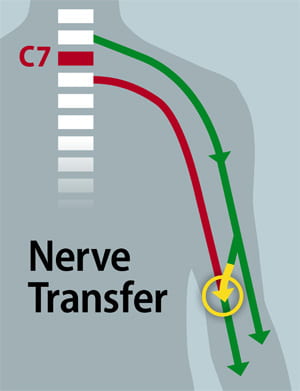Background
Spinal Cord Injury (SCI) is a devastating and life-changing condition, especially when it occurs in the cervical spine (neck) causing the loss or partial loss of sensation and function of arms and legs (tetraplegia). People living with tetraplegia depend on others for all, or almost all, of their daily activities, including feeding, writing, bathing, grooming, self-catheterizations and transfers from one place or position to another.
Hand function is consistently rated as the most desired function for persons with tetraplegia. That is above bowel and bladder function, sexual function, standing and pain control. Being able to recover even partial arm/hand function can have an enormous impact on independence and quality of life.
As part of a comprehensive program to treat patients with chronic spinal cord injuries, Dr. Ray offers nerve transfer procedures to provide improved arm and hand function to patients.
How Do Nerve Transfers Work?
Nerve transfers involve taking a working nerve in the arm that is connected to the spinal cord above the level of the patient’s injury and transferring that nerve to a nerve in the arm that comes from a level below the injury. The receiving nerve is still intact, but it cannot receive the signal from the brain in order to move the muscles. By re-innervating the receiving nerve, patients may be able to restore some hand and arm function.
In order for a nerve transfer to be successful, the following must be true:
- The segment of the spinal cord injured must be short with no syrinx.
- The joints cannot be too stiff.
- There must be available expendable donor nerves to use. (If an injury is too high, no nerves would be available.)
- Post-operative physical therapy must be available.
Please note that while nerve transfers may provide some improved hand and finger function, they will not provide anything approaching pre-spinal cord injury function. The goal is to enable the patient to be more independent in daily living.
Brachialis to Anterior Interosseous Nerve Transfer

The brachialis is an elbow flexor and lies immediately under the biceps. The brachialis nerve is one of the nerves that controls the biceps.
The AIN (Anterior Interosseous Nerve) is a branch of the median nerve that supplies the muscles that flex the thumb, index, and middle fingers. These muscles assist in making a fist or picking things up with the thumb and forefingers.
A brachialis to AIN nerve transfer procedure involves moving nerve fibers from the brachialis nerve and plugging them into the AIN to restore hand and finger function.

As you can see, the green nerve is an intact/working nerve coming from an area above the SCI. A branch of that nerve will be transferred to the red nerve that is an intact/nonworking nerve as it is coming from below the SCI. This will re-innervate the red nerve and allow it to receive signals to fire the muscles in the patients hand or arm.
Nerve Transfer vs. Tendon Transfers
Tendon transfer have had an established role in the treatment of tetraplegia patients. The nerve transfer does have several advantages over tendon transfers. As muscles are powered by different nerves, it is possible to take away one of those nerves to use in a nerve transfer without affecting the strength and function of the original muscle. One other advantage is that the nerve transfers do not require immobilization after surgery. Muscles can lose function when not in use. By being able to move right after surgery, the patient’s chance of losing muscle function in the arm is greatly reduced.
Nerve Transfer Pros/Cons:
- Recently considered for treatment in tetraplegia patients.
- Donor nerves are selected to allow the original function to be maintained.
- Does not require immobilization.
- Time Dependent – best result occurs within a few years of injury.
Tendon Transfers Pros/Cons:
- Established role in treating tetraplegia patients.
- Performed by using less important/less critical muscle-tendon units to restore lower motor function. This can cause loss of original function.
- Requires period of non-use/stabilization.
- Not time dependent – can be performed at any timeframe after injury.
The good news is that a nerve transfer does not prevent the possibility of having a tendon transfer at a later date. So, it may be possible for the patient to receive both treatments.